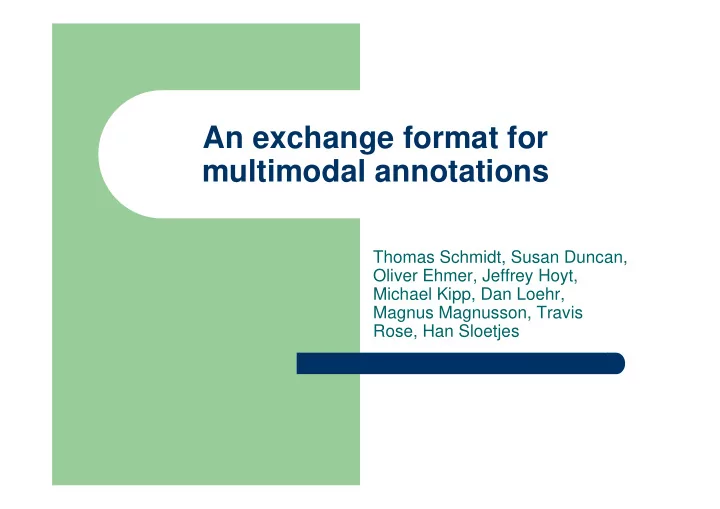

An exchange format for multimodal annotations Thomas Schmidt, Susan Duncan, Oliver Ehmer, Jeffrey Hoyt, Michael Kipp, Dan Loehr, Magnus Magnusson, Travis Rose, Han Sloetjes
Background � International Society for Gesture Studies (ISGS) – 2005 Conference in Lyon (‚Interacting Bodies‘) � User workshop on ‚Multimodal Annotation Tools‘ – 2007 Conference in Chicago (‚Integrating Gestures‘) � Developer workshop on ‚Annotation Interchange among Multimodal Annotation Tools’ � Goal: Interoperability between existing tools
Developer: Michael Kipp, DFKI Saarbrücken Tools (1): Anvil
Developer: Kevin Moffit, University of Arizona Tools (2): C-BAS
Tools (3): ELAN Developer: Han Sloetjes, MPI Nijmegen
Developer: Thomas Schmidt, University of Hamburg Tools (4): EXMARaLDA Editor
Developer: Travis Rose, Virginia Tech Tools (5): MacVisSTa
Tools (6): Transformer Developer: Oliver Ehmer, University of Freiburg
Developer: Magnus Magnusson, NOLDUS Tools (7): Theme
Interoperability C-BAS ANVIL ELAN EXMARaLDA Theme Transformer MacVisSTa
Interoperability C-BAS ANVIL ELAN Exchange Format EXMARaLDA Theme Transformer MacVisSTa
ELAN EXMARaLDA Data model comparison Denominator Information Common ANVIL
Data model comparison • Basic building blocks: Annotation tuples <start, end, label(s)> � Annotation Graphs as a general framework � AG‘s XML format as the base format • Differences: • General organisation of basic building blocks into larger structural units • Semantic specifications and constraints on structural units
Tier-based vs. Non-tier-based � Tiers = Partition of annotation tuples � No temporal overlap within a tier � In Anvil, ELAN, EXMARaLDA, Transformer � Construct partition from other information (e.g. categorisation of labels)
Implicit vs. explicit timeline � Implicit timeline: annotation tuples refer directly to media times � Explicit timeline: annotation tuples refer to points in a timeline which can refer to media times – Relative and absolute ordering of timepoints – Timepoints without timestamps possible � Interpolate timepoints without timestamps � Construct explicit timeline (identical timestamps?)
Tier specifications � Tier names (all) � Speaker assignment (ELAN, EXMARaLDA) � Tier types: – ANVIL: primary, singleton, span – ELAN/Transformer: time subdivision, included in, symbolic subdivision, symbolic association – EXMARaLDA: transcription, description, annotation
Tier relations and constraints � Parent/Child relations � tier hierarchy – explicit in Anvil and ELAN – implicit in EXMARaLDA � Other constraints arising from tier typing � Restrictions on label content – part of the tools‘ format?
Exchange Format � Lossless exchange of common denominator information � Uniformly encode all information beyond the common denominator � no lossless round-tripping, but... � ... all available information captured and... � ... lossless exchange in a chain of tools with increasingly complex data formats
Exchange Format
Exchange Format Tier definition: Fixed metadata attribute ‚TierIdentifier‘ Tier properties: Fixed metadata triple ‚Source‘ ‚Name‘ ‚Value‘
Implementation � Import / Export routines – ANVIL, ELAN: AGLib (Java port) – EXMARaLDA: XSLT stylesheets – Theme: Perl – MacVisSTa: Python – Transformer: Visual Basic
Conclusion ANVIL Results: C-BAS • Commonalities captured ELAN • Differences (better) understood EXMARaLDA • Basic interoperability established MacVisSTa • Link to generic framework established Theme Transformer Praat Exchange Annotation TASX Format Graphs Transcriber Specific Abstract
Outlook ANVIL ELAN � Partial correspondences – Simple: e.g. speaker assignments EXMARaLDA – Complex: e.g. parent/child relations � Modifying/Assimilating tools‘ formats � „Process-based“ (as opposed to format-based) interoperability?
Recommend
More recommend